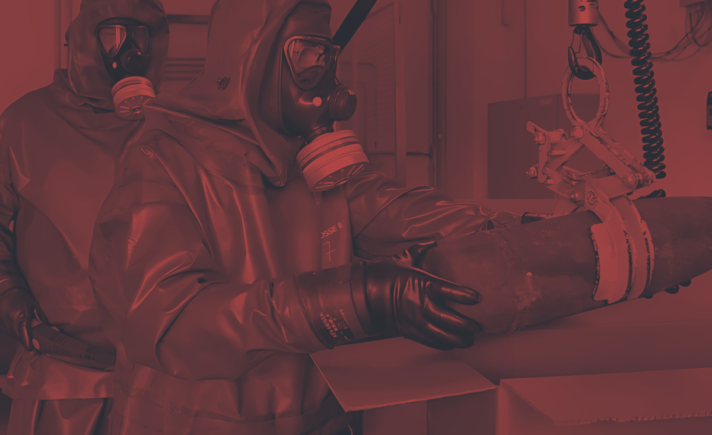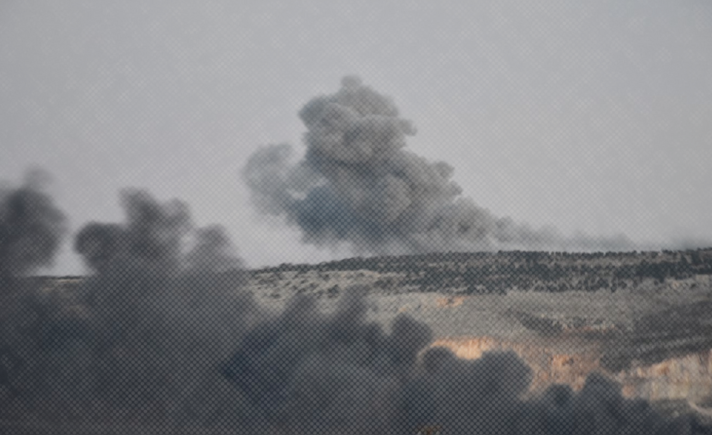[Editor’s note: This article is the first in a series of four originally published in Arabic by Al-Jumhuriya during the siege and bombardment of Eastern Ghouta, Damascus Province, which ended in April 2018 with the forced displacement of over 100,000 residents. The original Arabic version of this article, published on 27 March, 2018, may be read here. The four articles have been translated in cooperation with The Ghouta Campaign.]
The convoys of forcibly displaced persons moving out of Eastern Ghouta and heading north continue to gather in front of destroyed cities and towns. The pale faces of the residents who have spent the last few months in cellars were not affected by the one day of sunlight they got before leaving home. Perhaps they are having mixed feelings today, emerging from underground after months of relentless shelling that targeted what remained of their cities and turned it into ruins. Some will soon be reunited with their friends and parts of their families that were displaced from al-Qaboun district last year. All of them will see Damascus and the rest of Syria for the first time in five years.
A large number of residents chose to leave for the north with the displacement convoys. These numbers seem to have increased after frequent reports by Ghouta activists of infringements and arrests happening in Saqba and Hammouriya. This is in addition to reports about the regime creating a list of wanted people from Ghouta that includes civil activists such as members of the local councils of the towns, and the civil defense, as well as media and humanitarian relief activists. All of this has lead to an increase in the number of people who will be moved in convoys coming from the middle sector, which includes the towns of Jobar, Zamalka, Irbin, and Ayn Terma. These towns were under opposition control until the agreement with the regime’s forces was signed with Russian mediation. Activists have said that the number of people who registered their names to go to the north could reach 20,000, in addition to the batches that have already arrived to Idlib.
The third batch of the displaced coming from the central sector set off this morning in front of the neighborhood of al-Qaboun, joining the first two batches, which arrived in the last three days to the Qala’at al-Madiq crossing in the Hama countryside. This crossing separates regime-controlled areas from those controlled by the opposition in the north of Syria. Both of the first two batches amounted to more than ten thousand persons, among them civilian residents as well as fighters from opposition factions.
Two batches from Harasta, amounting to about 5,000 people, had already arrived at Qala’at al-Madiq. According to the Harasta city council’s Facebook page, from there they will be divided and sent to either the Saa‘ed or the Miznaz center in the towns of al-Atarib and Ma’arrat Misreen.
Under the current chaotic circumstances, it seems that determining the exact number of displaced persons is not possible. A source from the Free Damascus Countryside Council told Al-Jumhuriya, however, that, “the number could reach 100,000 displaced persons to the north if Douma were to make a similar agreement. This would amount to a disaster at the humanitarian level, especially considering that the organizations and civil bodies in the north, in the absence of any international support, are unable to absorb these large numbers.” Although several organizations have hastened to mobilize their full capacity in the north in order to absorb as many displaced people as possible, the increase in numbers may mean a near-total inability to provide assistance to those emerging from the siege.
Since the beginning of the year, the towns and cities of Ghouta have been subjected to an intense bombardment campaign in which regime forces and Russian planes have used bunker-busting weapons to target the shelters that protected civilians and the vital facilities that had been built in the cellars. Phosphorus and chlorine bombs were also dropped on densely-populated areas. After this bombing campaign, several battle fronts were opened in Ghouta. These included the southern sector in al-Nashabiyah, which fell into the hands of the regime after most of its inhabitants were displaced following the use of chlorine gas. The regime also heavily deployed troops at the hospitals front in Harasta city in order to separate it from the city of Douma by controlling the farms situated between the two cities.
The advancement of the regime’s forces on the Shiyfuniya and al-Ash’ari fronts enabled it to exert pressure to connect its controlled areas in the Harasta farms district with the troops that were coming in from the eastern axis. This occurred after heavy fighting in Mesraba and Mdira, two small towns near Harasta and Douma.
The collapse of the fronts in Hammouriya was averted by the Faylaq al-Rahman brigade in a final battle, but they collapsed again after civilians were subjected to the barrage of regime forces’ artillery fire. This led to the retreat of Faylaq al-Rahman to its positions in the towns of Irbin, Zamalka, and Ayn Terma. The latter witnessed the last episode of negotiations that took place between representatives from Faylaq al-Rahman and a Russian delegation, during which an agreement was signed and subsequently announced on the twenty-third of this month by Wael Alwan, the spokesperson of Faylaq al-Rahman.
As for the fronts in Harasta city, despite the inability of regime forces to make their way deep into the city, they did manage to create a breach large enough to isolate opposition fighters in Harasta from the rest of Ghouta’s towns. This was also achieved through a bombing campaign that led to the destruction of the city’s remaining neighborhoods and infrastructure. As a result, the leadership of the Ahrar al-Sham movement (the largest faction in Harasta) agreed to the withdrawal of their fighters, with their personal weapons, along with any civilians wishing to join them, in the direction of the north.
According to conflicting reports, a number of residents in regime-controlled villages and towns stayed among the rubble of their homes. Currently, there is no reliable information about their figures and situation. Meanwhile, the battles forced large numbers of Ghouta residents, especially in the central sector and Harasta, to leave their homes and make their way to crossings that are said by the regime to be safe for civilians. These include the technical services point in Harasta. Human rights violations have been recorded, however, throughout the passage of civilians. Those arriving to regime-controlled areas were put in overcrowded “shelter centers” that lack basic services. According to the regime’s media, about 100,000 Ghouta residents have now left through these crossing points. However, there are no statistics from international organizations regarding the numbers and conditions of the displaced persons there. Meanwhile, there are reports of an arrest campaign that targeted young people who were crossing.
In the city of Douma, the fighters of Jaysh al-Islam retreated to the periphery of the city after they lost Shayfuniya and the farms neighboring Harasta. This led to the siege of approximately 150,000 civilians within Douma. Despite the start of negotiations between a delegation from the city of Douma and the Russian side, the bombing of the city has not ceased. During the last meeting between the two sides last Sunday, it was decided there would be a truce throughout the negotiations. Neither Russia nor regime forces adhered to this. Statements made by the Deputy Chief of the Operations Room for the General Staff of the Russian Army, Stanislav Haji Mammadov, hinted that the agreement in Douma would be similar to those made in Harasta and the central sector.
Media outlets and activists have photographed regime vehicles being loaded with the abandoned belongings left behind in Harasta households. This is the picture of Syria today; a country being looted by local and foreign occupiers. As for Eastern Ghouta, which has now sustained successive massacres for five years, it shall remain under the rubble of its buildings, with many of its people waiting on the other side of the demarcation line in northern Syrian.






